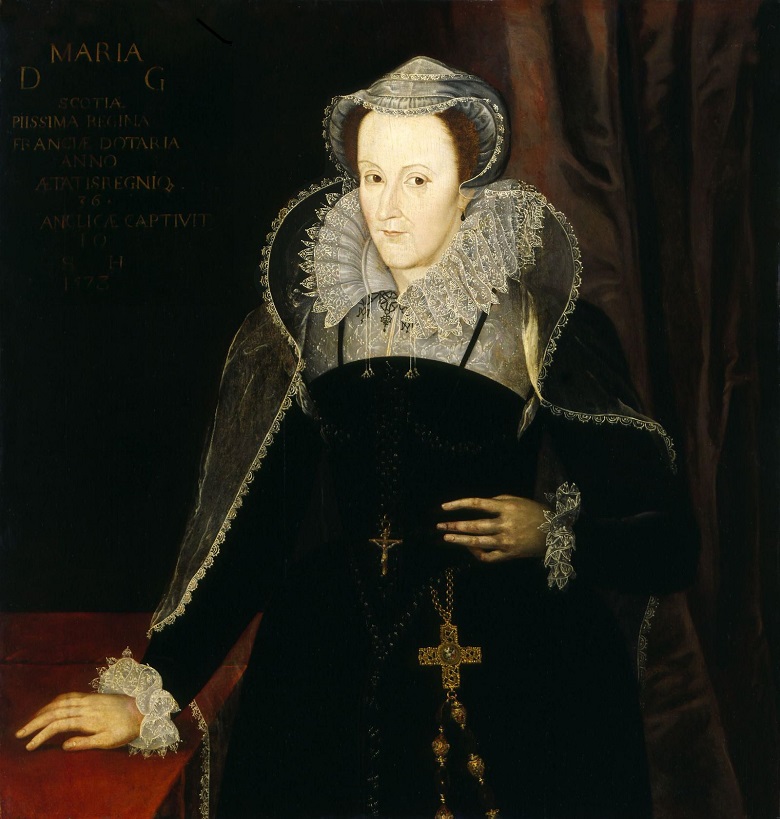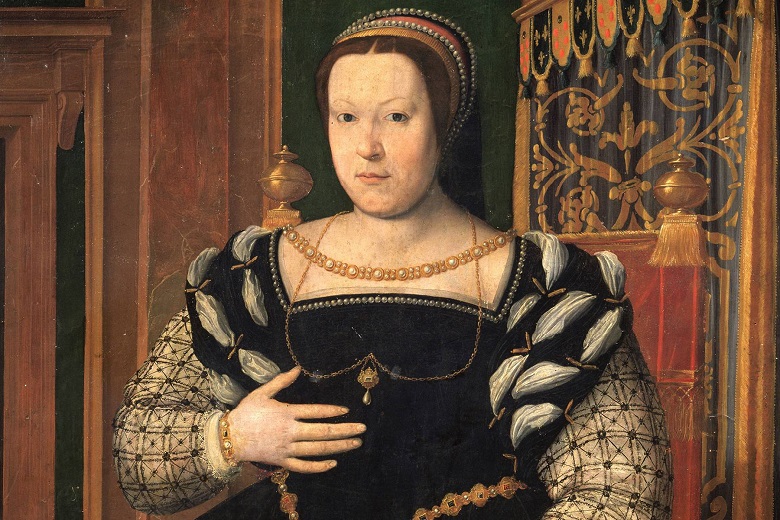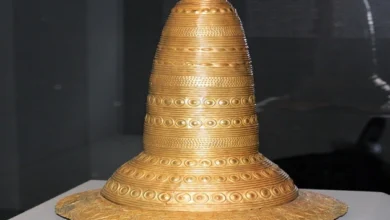The time of queens: how 5 women made politics in Europe in 16th century

While viewers of the TV series “Game of Thrones” see in the confrontation of queens a tribute to the fashion of feminism, history knows a time when several women determined the politics of Europe. They competed with each other, sometimes not for life but for death. A confluence of circumstances led to the fact that the sixteenth century can be safely called the “era of queens.” Five of these queens fought around the English throne.
Mary Tudor

When Henry VIII gave birth to his first healthy, viable child, his joy knew no bounds. Although she was a girl, he saw in her future sons just as solid and ruddy. The girl was named Mary in honor of Henry’s beloved sister, then Queen of France. The princess was assigned her colors: blue (the color of girls) and green. The clothes of all nannies, laundresses, maids and other servants of the princess were sustained in these colors. Wore the colors of little Mary and her teacher, a noble lady.
A prominent philosopher and educator of his time, the Spaniard Juan Luis Vives, was involved in drafting the curriculum for Princess Mary. The princess, among other things, studied the biographies of the great women of the past – both saints and martyrs and warriors. For physical development, Mary was engaged in horse riding and falconry.
While Mary Tudor was Henry’s only daughter, she was considered a desirable bride. Her future husband would get the crown of England! The father went over the suitors. Either Mary was engaged to a French dauphin, then to a Spanish king from the Habsburg family (by the way, her cousin). But one day, Henry got tired of waiting for Mary to have a brother, divorced and remarried. From the crown princess, Mary, according to the laws of that time, became a bastard. The grooms forgot about her.
Shortly after King Henry and his son Edward died one after another, Mary still received England. She was 31 years old. By this time, many English nobles had already embraced Protestantism. Mary herself was a fierce Catholic. She immediately set a course for the eradication of the “heresy” planted by her father. Bonfires blazed across the country, and Queen Mary turned into a “bloody Mary” for many. The nickname sounded rougher since the word “bloody” is used in English.
Mary herself, however, did not differ in bloodthirstiness. She was going to pardon the first of the protestants she executed. But then a protestant uprising broke out, and politics demanded human sacrifice. Maria brought them.
In the summer of 1554, at the age of 38, the Queen married the Spanish Prince Philip of the Habsburg family, the son of her previous groom. The husband was Mary’s cousin. By the marriage agreement, Philip had no right to interfere in the internal affairs of England.
This is not to say that the Spanish prince did not try to become the ruler of England. Mary sought his recognition as the king, but parliament harshly dismissed all of Philip’s claims. Maria also failed to get pregnant, which drove her crazy.
In September 1558, Philip’s father died, and the prince went to a funeral in Spain, where he was to be crowned at the same time. After her husband left, Mary became seriously ill. Before her death, she approved her younger sister, Elizabeth, as her heiress.
Virgin Elizabeth

The most unloved stepmother of Mary Tudor, Anne Boleyn, for whose sake Henry divorced Mary’s mother, gave birth to his daughter, named after Henry’s mother, Elizabeth. The girl was very similar to her father, and so he liked her. This did not stop him from executing her mother when she got tired and wanted to take a new wife. The marriage to Boleyn was declared null and void, and Elizabeth, like her older sister, was in the position of a bastard.
Fortunately, she studied with her younger brother, Prince Edward, and received no less brilliant education than her older sister, perhaps better because Edward was trained to rule the state.
Edward’s mother was distinguished by a kind disposition and made many efforts to ensure that Henry improved relations with her daughters. Unfortunately, she died from complications in childbirth. But Edward grew up with her gentle character, adored the sisters and as a result, willingly or unwillingly, contributed to both the reduction of their mutual hostility and the fact that his father again remembered them and included them in the inheritance list. The death of her brother from tuberculosis became real grief for Elizabeth.
The endless executions of her father’s wives from her youth turned Elizabeth away from the idea of marriage. She confessed this to one of her stepmothers, Catherine Parr, in a letter. By the way, they corresponded in Latin.
After the death of her father, Elizabeth remained with Parr. But Parr’s new husband began to molest the girl, and Catherine sent her stepdaughter to a distant estate, trying to protect both her and her marriage. This is not to say that Elizabeth was forgotten. At the estate, she continued her studies. And she stayed there for a short time. Soon her brother called her to his court.
Upon the accession of Mary, Elizabeth, as a Protestant, was in danger. First of all, because co-religion nobles would try to use it as a flag in any coup, Mary imprisoned her sister in the Tower – a royal prison. Mary did not feel any love for Elizabeth. She declared her sister the heiress under pressure from her husband.
Oddly enough, when Mary became seriously ill, Philip did everything for Elizabeth to ascend the throne without problems. Elizabeth generally knew how to please people.
Elizabeth’s reign went down in history as one of England’s golden ages. It brought the country a flourishing of culture and science, an increase in foreign policy influence, and, by the way, a fashion for a healthy lifestyle, especially for hygiene. True, Elizabeth had to demonstrate an iron character to keep the throne for herself. There were enough applicants for ownership of England, and they all continued to view Elizabeth as Henry’s bastard.
Elizabeth never married and did not have a single official lover. So for her accomplishments, she went down in history as the Great, and for her personal life – as the Virgin Queen. To all questions, Elizabeth reported that she was married to England.
Mary, Queen of Scots

King Henry fought not only with Catholicism but also with his neighbor, the Scottish King James. He was Henry’s nephew, but they did not feel any kindred feelings for each other. The wife of the Scottish king was the daughter of the French duke of Guise, Mary.
During the armed conflict between the British and the Scots in 1542, James suffered a crushing defeat – primarily due to the massive desertion of the Scots. It knocked him down. He died of grief. His newborn daughter Mary Stuart was declared Queen of Scots. The Earl of Arran became the official regent under her. His pro-English sentiments were much disliked by the widowed Queen, who, of course, saw a future for Scotland with France.
Arran first arranged the engagement of little Mary to the six-year-old Prince Edward, the son of Henry. Meanwhile, Mary de Guise, relying on pro-French-minded nobles, began a power struggle. The first result of the struggle was the breakup of the engagement even before the year’s expiration. Later, de Guise married a daughter to the French Dauphin Francis and sent the baby to the French court.
All the same, in the question “who will rule Scotland in the coming years,” only two names were assumed: Count of Arran or Mary de Guise. Mary Stuart was too young even to sign the documents.
Stuart had an excellent relationship with her fiancé. They were friends; everyone around seemed like a lovely couple. Stuart was brought up believing that she had the right to one day be called Queen of three countries. Scotland was already hers. She would become the French Queen after marriage. And she had the right to the throne of England after the death of Edward and Mary as a legitimate descendant of Henry VII. Her mother never tired of reminding her of this.
Mary de Guise, meanwhile, had developed a taste for power and was in no hurry to represent French interests in Scotland. At the same time, she was handing out promises left and right to get financial and military support. Acting in the most critical situations with the Earl of Arran, however, in 1554, de Guise has achieved his removal from the post of regent. She now officially represented her daughter.
And unofficially, it was de Guise who was now the reigning Queen. True, not very long. Five years later, a Protestant uprising broke out in Scotland. The British brought in troops to help them. The war very quickly cut short both de Guise’s political career and her life.
When Mary Stuart was seventeen, her fiancé became King of France. They got married. They were young and had little interest in the affairs of the state. Power was concentrated in the hands of the brother’s Mary de Guise, the uncle of the young Queen.
Alas, a year after the wedding, Mary Stuart was widowed. Francis died of a fistula in his ear, which eventually led to gangrene. Stuart lost her husband six months after her mother died. After burying Francis, she returned to Scotland.
The father of Mary Stuart Jac ruined Scotland. Now she was also split by religious strife. Mary, like the serial Queen Margery, relied on her ability to please people. Discreetly staying away from religious controversy, she turned her court in Scotland into a French court. She brought into fashion masquerades, balls, hunting, and golf.
This attracted young aristocrats to her, both from among Catholics and Protestants. They stood by the young Queen, and frequent contact with each other made them more tolerant of religious opponents.
Mary left the country’s government to those lords already dealing with domestic and foreign policy issues. She disagreed with them on only one point. The lords wanted the union of England and Scotland, Stuart insisted that Elizabeth usurped the throne, which legally belongs to Mary. Stuart everywhere declared her rights publicly, and Elizabeth was, of course, angry. Relations between England and Scotland continued to cool.
Probably, Mary would have been able to stay on the throne for a long time if she had not managed to fall in love. She married her cousin, Henry Stuart. This, in general, was not new among the ruling circles of Europe, but Mary unpleasantly impressed the Catholics of Scotland by not even waiting for the permission of the Pope. In addition, this marriage deprived Scotland of the chance of all beneficial alliances with the ruling houses of Europe.
Mary’s marriage to her cousin was the first unsuccessful step that led to a string of events, because of which she first lost the throne as a result of the rebellion. Her son, the future King James VI, was taken away, and Mary herself had to flee to England and beg Elizabeth as her aunt for shelter and help. Elizabeth imprisoned her niece at Sheffield Castle.
The prisoner did not tolerate hardships. At her service were maids, footmen, cooks, laundresses, a hairdresser, and a tailor. All this was paid from the English treasury. But Mary did not lose hope of getting the English throne. She corresponded with the heads of European powers and Catholic conspirators in England. In general, Queen Elizabeth quickly got tired of it, and Mary’s head was cut off.
Catherine de’ Medici

The Italian duke’s daughter had a difficult childhood. Her mother died of complications in childbirth; her father outlived her by a few days – not from grief, from syphilis. The girl was raised first by her grandmother and then by her aunt. She was taken hostage at the age of eight when Charles V, the one they once wanted Mary Tudor to marry – laid siege to Florence. The girl listened to threats of murder and gang rape every day for six months. Eventually, the threat of starvation loomed over the city. Florence surrendered, and Catherine was returned to her relatives.
Although in her youth she became the wife of a French prince, this did not bring Catherine happiness. When she first arrived in France, it turned out that Pope Clement VII, Catherine’s uncle, had died, and the new Pope refused to send the dowry. Dowries were not favored in those days. The attitude of the French court towards Catherine was cold.
Nor could her manners improve matters. The Medici had almost none. Unlike English and French princesses, she was not well educated. At her rudeness laughed almost to the eye and called “merchant.” Her husband was openly unfaithful.
When Prince Henry, Catherine’s husband, ascended the throne and became Queen, attitudes towards her changed little. She had no political influence. She did not even have the right to represent her husband in his absence.
Motherhood brought some problems. At first, Catherine did not manage to get pregnant. The doctor, better known as the alchemist and fortuneteller, Nostradamus, helped her. Catherine gave birth to ten children one by one.
After the death of her husband from an accident, Catherine put on black clothes and did not take them off until the end of her days – for this; she was nicknamed the Black Queen. But by her thoughts, she did not at all renounce everything earthly. Catherine was going to rule the country. The entire short reign of her son Francis was spent in a power struggle. Francis entrusted the country’s administration to de Guises, the relatives of his young wife, and Catherine tried to intercept him.
In addition, she supported Mary Stuart’s claims to the English throne. Seeing her son as king of England in advance, Catherine promised Mary military support. However, Francis died before he was seventeen. Mary departed for Scotland. Catherine had to temporarily focus on France and the struggle to keep power in the hands of her family.
The ten-year-old brother of Francis Karl was declared king. Naturally, Catherine was the regent with him. But even after Charles grew up, she had a significant influence on him – the young king was used to obeying his mother. It was by the decision of Catherine that St. Bartholomew’s Night was arranged – a great massacre of Protestants by Catholics.
Charles died of tuberculosis at less than twenty-four years of age. His last words were an exclamation: “Oh, my mother!” His younger brother Henry became king. Fortunately, he outlived his mother for six months; otherwise, she would have had a tough time. After all, before that, another of her son, Hercule François, and daughters Elizabeth and Claude had died. This is not counting the children who could be buried in infancy.
Henry obeyed his mother much less than Charles, but it was no longer possible to kick Catherine out of politics. She remembered the English throne and tried to put her son Hercule François there, arranging his engagement to Elizabeth. Alas, the engagement was canceled after François failed the military campaign in the Netherlands. Catherine also traveled with diplomatic missions throughout France, trying to stabilize the situation with the Huguenots. After St. Bartholomew’s Night, it was not easy.
In addition to politics, Catherine invested in art. Her collection of paintings numbered 476 changed the cuisine of France and influenced architecture. Eventually, she died of neglected pleurisy, though many contemporaries believed it was her son Henry, then King of France, who had driven her to her grave with his wantonness and irreverence.
However, in the history of Europe, the unhappy mother went down as one of the cruelest rulers of the Middle Ages.
Mary of Hungary

The queens of the sixteenth century were marked not only by plans and claims to the throne of England. Mary Tudor’s cousin Mary Hungary was indifferent to the English throne – he was too far from her. Her political interests were in other areas of Europe.
In the family of the first king of the Habsburg family, she did not differ in beauty from childhood, for which Catherine Tudor and Mary Stuart loved. But she was distinguished by her intelligence and, as it turned out with age, political giftedness. In addition, she had a sharp tongue. You could write down her poisonous and well-aimed remarks. The little king of Hungary and Bohemia, Lajos, was chosen as her suitors. At the time of the wedding, she was ten years old; he was nine.
The relationship between Mary and Lajos was friendly from the very beginning. In foreign policy, Queen Mary became her husband’s first assistant. When Lajos died in 1526 in a battle with the troops of Suleiman the Magnificent, she sincerely grieved. When Mary’s aunt tried to arrange a new marriage for Mary with the Scottish King James Stuart, the future father of Mary Stuart, Mary of Hungary strongly opposed it.
After the death of Lajos, Mary’s brother Ferdinand became king of Hungary, but for several years it was she who ruled on his behalf. In 1530, her other brother, King Charles V – the same one with whom Mary Tudor was in love and who freed Catherine de’ Medici from Florence – asked Mary to take over the management of the Netherlands. The country fell to her in complete ruin. In addition, it was torn apart by different states.
The results of Mary’s reign must have come as a surprise to her brother. She significantly improved the country’s financial situation and made the Netherlands independent from France and Charles V’s empire. The Catholics of Europe constantly accused Mary of protecting Protestants, political enemies – in an unfeminine sarcastic manner of conducting a conversation. Although Mary loved her brother very much, she defended the country’s interests entrusted to her so firmly that it came to quarrels with Charles. But the people adored Mary. Thanks to her support, who willingly bought paintings, Dutch artists flourished. She also became a philanthropist for musicians in both Hungary and the Netherlands.
Having retired, the dowager queen left for her mother’s homeland in Castile. Both the brother and then his son Philip several times persuaded Mary to take control of the Netherlands again, but Mary refused. When she finally decided to return to Holland, her brother Charles died. Maria suffered two heart attacks in a row from experience and died.




